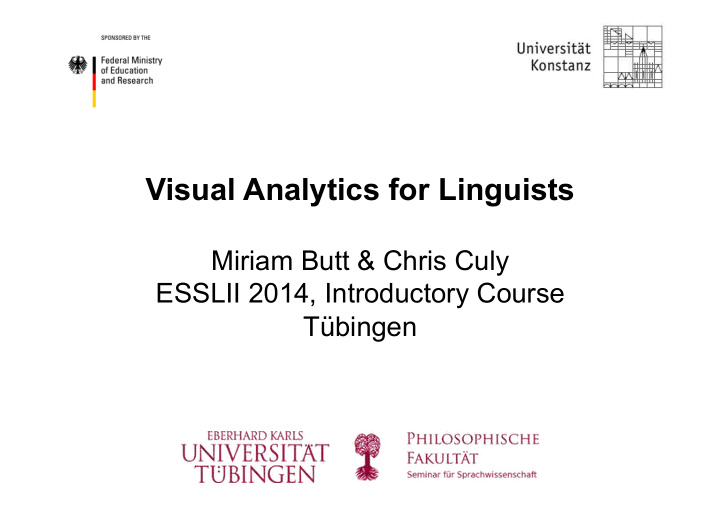



Visual Analytics for Linguists Miriam Butt & Chris Culy ESSLII 2014, Introductory Course Tübingen
Day 5 – Summary • Interaction between Visual Analytics and Linguistics • What kind of data? • What kinds of hypotheses? • Insights from working with the software? • Outlook 2
What interests Visual Analytics? • Interesting interactions – beyond just basic data types – push the boundaries/limitations of visual variables. • Multiple dimensions (beyond 2) • Time depth ¡ • Cross-modular interactions. • Not just coloring in bits of text that are of interest. • Or drawing lines between pieces of data. • In short : Analysis at a Meta-Level 3
What is complex in linguistics? • Complex interactions between different parts of the grammar. • Complex linguistic representations (trees, AVMs, pitch contours, etc.) • Comparison of different languages/dialects – crosslinguistic (typology/dialectology) – diachronic (across stages of time) ¡ • Complex interactions across different texts. 4
What is good for Linguistics and Visual Analytics? • Sets of data which have complex interactions that you are interested in exploring. • Interactions/data that are too difficult for you to eye- ball in its “raw” form. • Large amounts of data that you want to have an “at- a-glance” overview of. • Keim’s Mantra: overview first – details on demand 5
Data • The Visual Analysis depends on the data. • It does not make the data, it just helps you understand it. • So: – be clear on what questions you are investigating – on what kind of data you are working with – whether Visual Analysis will be able to help – what kinds of interactive possibilities you might want • You do not necessarily have to perform a statistical analysis (though that is becoming more and more common) – cf. the Levin Verb Classes Example. 6
Hypotheses • Visual Analytics provides a fundamentally explorative approach to data. • You can just take a bunch of data and go explore. • However, it is good to have a hypothesis. • Following cycle: – Formulate Hypothesis – Gather and Process Data – Visualize Data – Test Hypothesis and maybe reformulate Hypothesis – Reprocess Data (e.g., different annotations, focus on different features) – Revisualize – (Re)Test Hypothesis – Start Over 7
Working with the Software • Particular low-level issues – Make sure the data is in the right format (e.g. UTF-8) – For the Cluster Visualization • Use the “customized” option for new files (not “quick”) • do not specify anything for the bigrams • do not try to compute with features that are not numbers • Otherwise several of you: – identified bugs – identified features in the software that you would like to have Very good and Thank You! 8
Working with the Software Further reports on experiences/feedback? 9
The ¡MOTH ¡Manifesto ¡ Ordinary ¡researchers ¡should ¡have ¡access ¡to ¡high ¡ level ¡visualiza8ons ¡and ¡analysis ¡tools ¡ ¡for ¡their ¡ own ¡data. ¡ ¡ Culy ¡2014 ¡ 10
Goals ¡for ¡Developing ¡Visualiza8ons ¡ • Make ¡them ¡independent ¡of ¡any ¡par8cular ¡ data ¡set ¡ • When ¡possible, ¡make ¡them ¡(also) ¡independent ¡ of ¡a ¡par8cular ¡applica8on ¡ – E.g. ¡as ¡components ¡ • Use ¡common/easy ¡file ¡formats ¡for ¡the ¡data ¡ ¡ • Give ¡examples! ¡ 11
Research ¡in ¡LingVis? ¡ • Classifying ¡the ¡(higher ¡level) ¡types ¡of ¡data ¡ • Classifying ¡the ¡ kinds ¡of ¡tasks ¡we ¡want ¡to ¡do ¡ – The ¡ques8ons ¡we ¡want ¡to ¡answer ¡ • Figuring ¡out ¡how ¡to ¡match ¡data ¡+ ¡task ¡with ¡ visualiza8ons ¡ – e.g. ¡the ¡different ¡network ¡visualiza8ons ¡ • Figuring ¡out ¡how ¡visualiza8ons ¡can ¡be ¡ connected ¡together ¡in ¡applica8ons ¡ 12
Outlook • Where do we go from here? • Where do we see the field as going? 13
Recommend
More recommend